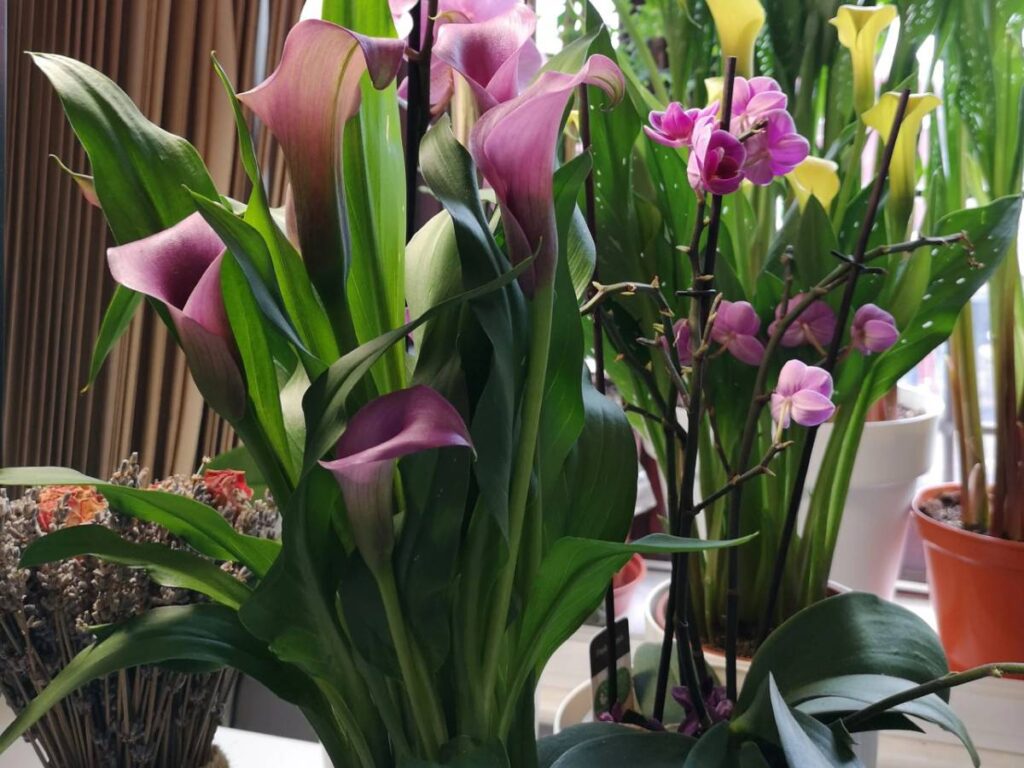Calla lilies are a beautiful flower that adds elegance and sophistication to any garden. They are popular for their stunning trumpet-shaped blooms, which come in a variety of colors, including white, yellow, pink, and purple.
But what many people don’t know is that calla lilies are actually perennials, meaning they will come back year after year with proper care.
In this article, we’ll discuss the basics of calla lily care and why these flowers make such great additions to any garden.
Are Calla Lilies Perennials?
Calla lilies are perennial plants that grow clumps of leaves before their trumpet-shaped blooms appear. They are typically hardy and have a long flowering period once planted. They typically flower in early summer and bloom from 6 to 12 weeks later, in late spring or early summer.

What Are Perennials?
Calla lilies are a beloved addition to gardens and landscaping. Boasting large, trumpet-shaped blooms, they gracefully adorn the sides of homes and add extra color to yards during the summer months. But what sets them apart is that they’re perennials: plants that come back time and again for years on end.
Perennials are more beautiful and last longer than their annual counterparts. They also require less care than annuals. With calla lilies in particular, gardeners get to enjoy vibrant hues of white, pink, and yellow, among others, without having to replant each year. A perfect perennial for those looking to add vibrancy to their garden or landscape!
Difference Between Annuals and Perennials
When it comes to plants, you should be aware of the difference between annuals and perennials. Annuals are plants that only last one season, while perennials are much heartier and live for multiple years.
Annuals require regrowth each season, as they just don’t last long enough to benefit from germinating year after year. Perennials, however, are planted once and will come back every year when taken care of properly. Also, they take a lot more work to get started, but if you give them the right conditions, they can live for many years.
On the other hand, calla lilies are a handsome example of a perennial variety, as they bloom in late spring or early summer. To create a lasting effect with Callas, make sure you understand their care requirements and choose suitable conditions, such as climate and soil type, for them to prosper.
How Long Do Perennial Plants Live?
Perennial plants are known for their ability to keep coming back year after year. But just how long can they live? Generally speaking, some perennials can live up to several years and even longer than a decade, depending on the type of plant.
For example, while calla lilies are considered short-lived perennials, meaning that they will usually only live for two to three years, with proper care, you can extend their lives. This includes providing them with plenty of sunlight, water, and nutrients, as well as pruning the flower back after it blooms.
All in all, if you’re looking for a low maintenance yet beautiful option with long-lasting results, then perennial plants could definitely be a good choice since they have been known to last many years!
Benefits of Growing Perennial Plants in Your Garden
Growing perennial plants in your garden is a great way to reap the rewards. Perennials are low-maintenance, cost-effective, and provide year-round interest with their beautiful blooms and foliage.
Plus, these plants attract beneficial wildlife to your garden, like butterflies, bees, and birds, helping to keep it healthy.
Perennials come back every year and require less attention than annuals do. They handle unexpected weather conditions better as well.
Also, perennials are usually cheaper than annuals because you can split them up and move them around, giving you more for your money.
When you choose to grow calla lilies in your garden, you get all of these benefits plus gorgeous flowers that last throughout the season.
So what are you waiting for? Consider planting perennials in your outdoor space today to enjoy their beauty all year!
Planting and Growing Calla Lilies
If you want to get beautiful calla lilies blooming in your garden for years to come, planting and growing them is fairly straightforward.
To start, pick a spot that gets plenty of direct sunlight and has well-draining soil. If you’re planting in a pot, make sure it’s at least 6 inches deep.
Then, plant the bulbs in spring or fall, making sure they are 6 inches deep and spaced around 6 inches apart. Water the soil afterwards to help the bulbs settle in.
Once they’re planted, you’ll need to give them regular waterings so that the soil doesn’t dry out quickly; adding a layer of mulch around the bulbs can help retain some moisture. As long as you take these steps, your calla lilies should be up and blooming by late spring or early summer.
Deadhead flowers after they’ve bloomed for more floral displays year round, and then cut back foliage when it starts to die off for the best results.
With minimal effort on your part, calla lilies will come back year after year to brighten up your garden space—how lovely!
Maintaining Perennial Plants in the Garden
Maintaining calla lilies in the garden requires a few simple steps. It’s important to keep the soil moist and well-drained. Calla lilies prefer a soil pH of 5.5 to 6.5, so regular testing and adjustment of the soil as needed is recommended.
Fertilize the plant in early spring and again in mid-summer with a balanced fertilizer. Water the plants regularly and mulch in the summer months to help the soil retain moisture.
Regular deadheading of the flowers encourages plants to produce new flowers throughout the season. Prune the plants after they go dormant in early fall to keep them healthy and bushy.
Divide calla lilies in late summer or early fall to create more plants. This can be done every two to three years to ensure the plants remain healthy and productive.
By following these simple guidelines, you can ensure that calla lilies will remain healthy and beautiful in your garden for many years to come.
Reasons to Plant Calla Lilies
There are plenty of reasons why you should consider planting calla lilies in your garden! Not only are they perennials that require minimal maintenance, but they also bring a splash of vibrant color to your landscape, with a variety of colors from reds and yellows to whites and pinks.
Calla’s are also known for their impressively long-lasting blooms, which can last up to eight weeks. As if that weren’t enough, these beautiful blooms are low-maintenance and thrive in well-drained soil, which makes caring for them even easier!
Even better, once planted they come back year after year, giving you an evergreen display throughout the summer months.
Overall, calla lilies make a great choice for any gardener looking for a low-maintenance and vibrant addition to their garden!
How to Care for Calla Lilies
Taking care of your calla lilies is important if you want them to stay healthy and beautiful. Here are a few tips to keep your calla lilies looking their best:
– Plant calla lilies in well-draining soil and in a spot that receives plenty of bright, indirect sunlight.
– Water your calla lilies regularly and make sure to keep the soil moist but not wet.
– Fertilize your calla lilies with a balanced fertilizer at the beginning of the growing season.
– Deadhead the flowers when they start to wilt to keep the plant looking neat.
– Cut the flower stalks to the ground after the blooms have faded.
– Mulch your calla lilies in the winter to protect its roots from extreme temperatures.
By following these simple tips, you can ensure that your calla lilies stay healthy and vibrant for many years to come.
Varieties of Calla Lilies
Vibrancy requires knowledge. Knowing the variety, the needs, and having dedication are all that’s required to thrive.
Calla lilies come in three common varieties: Palustris, Acaule and Aethiopica. Each offers a unique composition of colors. The Palustris has white petals with a yellow center; Acaule has deep purple and a white center, while Aethiopica is bright yellow and features white accents.
Perennials by nature, Calla lilies bloom each year if given adequate sunlight and properly cared for – fertilising in spring and regular watering is key for bountiful blooms come summer months but considering their sensitivity to temperature even winter months can be rewarding too.
While these flowers are not hardy plants they are undoubtedly resilient when their requirements are met – temperatures remain balanced, they bask under the ever-warm sun and sufficiently hydrated in moist soil.
Guided by experience allows us to revel in bold botanical brilliance every season with stunning displays of Calla Lilies perfected through time-honoured cultivation techniques.
Interesting Facts about Calla Lilies
Calla lilies are an incredibly popular choice for many gardeners, thanks in part to the fact that they require very little care and are incredibly easy to grow. Not only that, but these gorgeous plants actually have a very interesting history too!
For starters, these flowering herb-like plants come from South Africa, where they were first cultivated in Europe during the 17th century.
The name “calla” has even been derived from the Greek word “Beauty” which is highly fitting considering their unique beauty.
Calla lilies can range in color from white to yellow to pink and even deep purple – adding extra flair to any garden.
On top of all of this, calla lilies are even edible! They can be used as a great way to add color and flavor to salads or other dishes while also being perennial – meaning they will come back year after year if cared for correctly.
Plus, when in bloom the flowers can last up to two weeks and their leaves can grow up to three feet longs – really making them stand out and amazing addition for anyone’s garden!
Color Options of Calla Lilies
When it comes to adding a touch of beauty and color to your garden, calla lilies have you covered. In easy-to-find hues of white, pink, orange, yellow, and deep purple these brightly coloured flowers make an attractive bouquet or centerpiece for any occasion.
And if you’re looking for something really special, variegated calla lilies provide shades of landscape with the mix of colors they show off on their petals and leaves.
Rarely seen shades such as black and blue add drama-making potential with this stunning flower variety. With such an array of calla lily color choices available it’s not hard to find something that suits every space in your garden.
Add statement blooms that will draw in plenty of attention – get creative with the endless color options calla lilies offer you!
Common Problems with Calla Lillies
Calla lilies are perennials, but like any plant, they can be susceptible to a few common problems.
Root rot is the most common of these problems and it’s caused by overwatering. To prevent this from happening, make sure that you only water your calla lilies sparingly and wait until the soil is dry before doing so.
In addition to root rot, insect pests can also be an issue for calla lilies. Aphids, mealybugs, and spider mites can all feed on the plant and cause damage if left unchecked. To avoid this, inspect your plant regularly and use an insecticide if necessary.
Finally, fusarium wilt is a fungal disease which can attack the roots of your calla lillies, reducing vigor and causing yellowing or wilting leaves. The best way to avoid this problem is by planting them in well-draining soil and avoiding overwatering.
Tips For Successful Care and Maintenance of Calla Lily Plants
Maintaining your calla lily plants is key to enjoying the beauty of these gorgeous perennials year after year. To make sure your lilies remain healthy and vibrant, here are some tips for successful care and maintenance:
First, it’s important to make sure that your lilies are planted in a spot that gets plenty of sunlight. These plants need at least six hours of direct sunlight each day, so be sure to put them in a well-lit area.
Additionally, ensure that your soil is well-draining – if the soil holds too much moisture, the roots can become damaged or rot away.
It’s also important to water your lilies regularly but carefully – let the top inch of soil dry out between watering sessions. During the winter months, you’ll need to reduce watering frequency to only once a month. If possible, try using rainwater instead of tap water as it can have more benefits for Calla Lily plants.
Final Thoughts
In conclusion, calla lilies are beautiful and long-lived plants that can make a great addition to any garden.
These plants are perennials, which means with the right care and maintenance you can enjoy their beauty for many seasons to come.
While calla lilies may require careful tending to get them through the winter months, they will definitely brighten up your space all year round.







